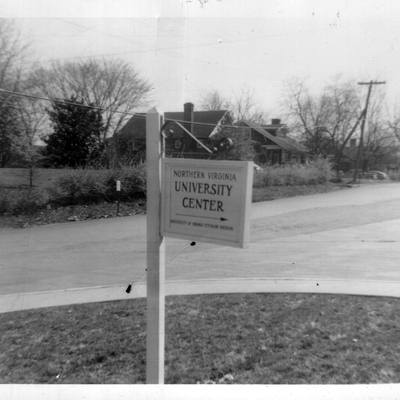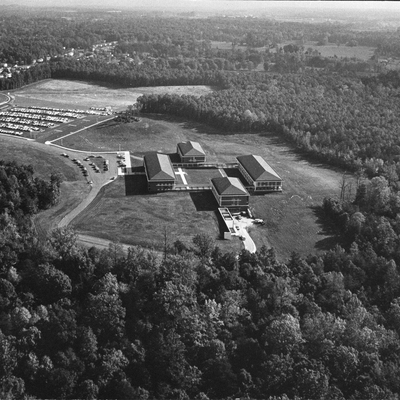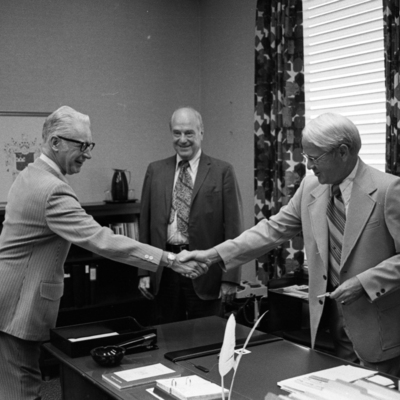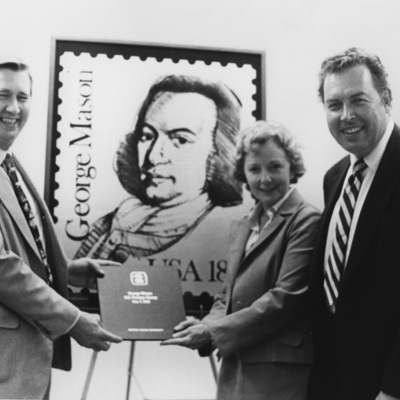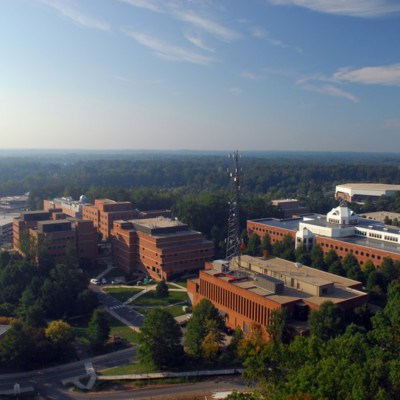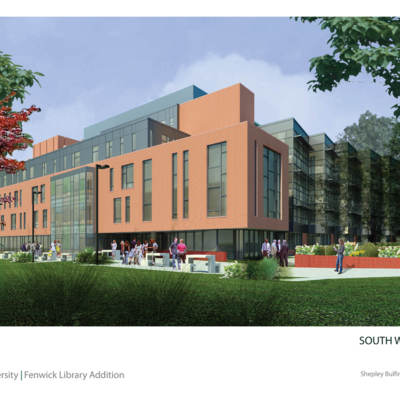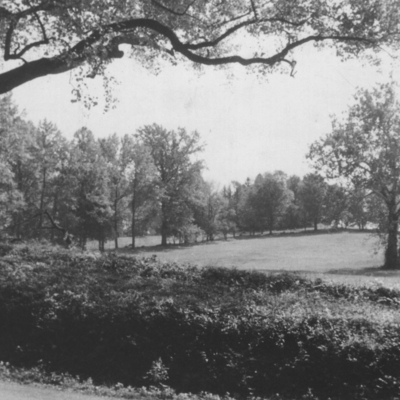President Ángel Cabrera: Working for Access to Excellence
Soon after George Mason University’s new president, Dr. Ángel Cabrera, officially took office on July 1, 2012, he was tasked with spearheading the creation of a new vision for the university. Cabrera was entrusted with this monumental project by Mason’s Board of Visitors, who asked him to draft a new set of ideas to guide George Mason into the future. Mason’s sixth university president began his tenure by overseeing the creation of an optimistic, forward-thinking agenda for a university already named among nation’s most up-and-coming institutions.
Both Cabrera and the board were well aware that Mason was part of a rapidly changing academia, full of challenges to the viability of higher education. In a resolution of August 17, 2013 the board asked Dr. Cabrera to create of a new strategic vision that would help Mason remain relevant and competitive in the future.
Accepting this task, Dr. Cabrera set to work on assembling a team of university stakeholders to help him formulate ideas. The vision would have to address emerging challenges Mason and other universities would face in the coming economic and technological climate, particularly funding, technology, and public perception. The vision would be used to guide the upcoming strategic planning process in 2014.
Eight working groups were established to focus on pertinent issues that were identified during President’s Council sessions with the Board of Visitors in early August of 2012. The groups studied the following issues: program innovation and growth; funding and resources; research; online education and executive education; global strategies; regional strategy; values and the Mason graduate; and student value and affordability. The working groups were overseen by a steering committee, which organized their findings and processed them into “big ideas.” [1]
Sixteen town hall-style meetings were scheduled across the three Mason campuses, Fairfax, Arlington, and Prince William. Students, faculty, staff, families, alumni, and community members were encouraged to attend these general meetings and give input regarding the university’s future. A number of shorter-in-length focus group meetings were arranged for members of the Mason community to address particular working group topics. Numerous e-mail notifications to students, faculty, and staff, as well as an updated website, kept participants informed throughout the process.
All told, the process was said to include more than four thousand individuals participating in committees, town meetings, and focus groups. [2] The drafting of the initial version of the Mason Vision document in February would include professional and analytical groups and members of the Mason community both internal and external. [3] Dr. Cabrera put this inclusivity into perspective, declaring: “The question [was] not ‘what are my plans for the university’, but ‘what are our plans for the university?”[4]
The initial draft of the Vision document was released on February 5th 2013. The 17-page document not only suggested initiatives Dr. Cabrera intended to implement during his tenure at Mason to address challenges to Mason’s viability in the future, but further defined, and redefined, Mason as an institution. [5] The Vision document identified six areas by which the University wished to define itself: the Motto; a redefined mission statement; a list of Mason’s core values as an institution; the characteristics of Mason graduates; and commitments the university intended to keep. [6] Perhaps most importantly, the Vision introduced the concept of the “Mason IDEA.” The letters in the IDEA acronym stand for characteristics Mason uses to describe itself: Innovative, Diverse, Entrepreneurial, and Accessible.
Speaking on what is contained within this initial draft, Dr. Cabrera stated: “There is one component that talks about what shouldn’t change, and then there is a part that talks about what should change.” [7] He continued on to imply that the process as a whole had been an effort in inclusion—a project that synthesized the opinions of all those affected. The purpose behind the release of the preliminary draft of the Vision document was to facilitate discussion. The Board of Visitors’ vote on the document was set for March 20, 2013. If the Vision were approved by the Board, it would then be sent to state higher education officials in Richmond for ultimate review and approval. [8]
With the Vision draft released and available to the public, the next step was to invite feedback from students, faculty, and community members on the content of the draft to aid in the shaping of the final Vision. Much like the town hall events held prior to the completion of the original draft [9], four townhall style events were announced by Dr. Cabrera. A fifth meeting was later added. Mason community members were invited to attend these events and provide input to the final vision process. An e-mail option was added for those with valuable ideas who found themselves unable to attend a town hall. And in keeping with its original inclusiveness, the process was opened to the entire community.
The five town hall meetings took place in the final weeks of February. They were spread out over the three Mason campuses so as to make them accessible to as many people as possible. Among the ideas suggested at these meetings was a consensus from the Student Government that parts of the final Vision include reference to enumerated and protected student rights. [10] As expected, some questions dealt with the ever-present theme of a possible NCAA-level football program at Mason, and Dr. Cabrera, diplomatic in his answers, discussed both the pros and cons of such a venture: “It’s a pretty expensive proposition. In an environment where we have so many pressures and demands to increase quality and to remain affordable to our students, we have to be very careful about it.” [11] The subject of football will no doubt remain a hot-button issue, but for the time being, it can be assumed that Dr. Cabrera felt that the cost passed on to students might not be worth having a program at that stage.
After another slate of town hall discussions, flurries of social media promotion, and a full semester of internal analysis and work, the Vision proposal was presented to the Board of Visitors on March 20, 2013. In a congratulatory letter to the University as a whole, President Cabrera lauded the efforts of all involved to create the official Mason Vision framework, which would move into the strategic planning process during the summer of 2013. “Now we have the foundation, the framework on which we can build a plan…the plans of each academic unit, for technology, for libraries—you name it,” said Cabrera on the completed document. [12] In addition to the official announcement, a festive e-mail was sent out to the entire Mason community and, in keeping with his propensity to leverage modern social media as a means of communication, Dr. Cabrera utilized his presence on Twitter to promote the news, as well. [13]
The drafting of the Vision for Mason, from conception to official outline, created a new mission statement that defines the university as “a public, comprehensive research university established by the Commonwealth of Virginia in the National Capitol Region…an innovative and inclusive academic community committed to creating a more just, free, and prosperous world.”[14] Dr. Cabrera has spearheaded a process that has succeeded in “craft[ing] a vision that [is] both aspirational and inspirational.”[15] With the visioning process concluded, the results of the work of the many individuals and groups were to be used to inform the university’s planning sessions for Mason's 2014 Strategic Plan.
The philosophy underlying the Vision and the 2014 Strategic Plan is the notion that Mason will find innovative ways to best serve the needs of its stakeholders, defined as students, the surrounding community, faculty and staff, and the world. The twelve goals to be accomplished in the plan do not serve the university’s needs or self-centered aspirations, but rather have potential value for others. [16] Mason would strive to be a top research university, making valuable contributions to the world, while remaining highly inclusive. Success would be measured by the value that it provides to the community that it serves, and not by accolades and the rankings. Besides, in October 2014, the Commonwealth of Virginia released a plan to exponentially increase the number of higher-educated Virginians by 2030. [17] George Mason University would play a large role in this endeavor.
Arguably, the university began to realize some of the goals enumerated in the 2014 Strategic Plan. On February 1, 2016 George Mason University was named a Research 1 institution by the Carnegie Foundation for the Advancement of Teaching. This classification made Mason a part of an elite group of about 115 institutions known for performing research at the highest level. The university saw an increase in research grants and expenditures in STEM, biomedicine, education, criminology and homeland security. Specific research work pertaining to treatment of HIV, detection of Tuberculosis, prevention of head trauma in athletes, Lyme Disease treatment, and prosthetic limbs for people with disabilities were of national interest. Mason also increased the number of doctoral degrees it awarded by 27% in that same period. [18]
And George Mason has made its programs accessible to a larger number of those seeking higher education, as well. In the Fall 2018 semester 36% percent of Mason’s undergraduate enrollment were the first generation within their families to attend college, while 52% of 2018 enrollees came from underrepresented racial or ethnic backgrounds. [19] This was the first year that George Mason could be considered a “minority-majority” university. George Mason and Northern Virginia Community College (NVCC)’s ADVANCE partnership, initiated in 2018, streamlined the transfer and graduation process so that transfers from NVCC can graduate from Mason in 2 years, while realizing the savings in tuition associated with attending a community college for the initial two years. [20] Overall, George Mason students accounted for 64% of the growth in enrollment for all 15 public four-year higher education institutions in Virginia between 2012 and 2019. [21]
Over that same period, Mason’s graduation rate grew to 70%. [22] In 2019 it was admitted to the American Talent Initiative, a coalition of elite schools known for very high graduation levels while expanding access and opportunity for highly-talented, moderate- and lower-income students. [23] George Mason joined the University of Virginia, Virginia Tech, and William & Mary as the fourth state university in that group.
On March 3, 2014 Mason opened Mason Korea as part of the Incheon Global Campus in Songdo, South Korea to 40 students. Mason Korea offers U.S. degree programs in five undergraduate disciplines. Its students spend three years at the Songdo campus and one year in the U.S. at Mason’s Fairfax, Virginia campus. [24] In 2020, enrollment at Mason Korea was about 400. [25]
Beginning in 2015 Mason’s Prince William Campus in Manassas, Virginia began a multi-year expansion of its facilities and programs. On April 23, 2015 the university officially opened its Institute for Advanced Biomedical Research (IABR). The IABR is a $40 million, 75,000-square-foot research facility housing university researchers working on advanced diagnostics and treatments for cancer, heart disease and other life-threatening diseases. It collaborates with community hospitals, regional medical centers and other major research universities. Research activities at IABR include personalized medicine, proteomics, cancer treatments, the study of Lyme Disease, nanotechnology-based diagnostics, and infectious diseases. Researchers from science, engineering, health, and education disciplines collaborate at the institute. The Prince William campus was renamed the Science and Technology Campus (STC) on the same day IABR opened, further defining its role in Mason’s distributed campus system. [26]
Further expansion of the STC was announced in the summer of 2019. Two new academic buildings, four-degree completion programs and housing for undergraduates, as well as a possible town center, were planned as part of Mason’s goal of more than tripling the current 1,000 full-time student population to about 3,550. One of two future academic buildings planned for STC is a 100,000-square-foot site consisting primarily of teaching labs, the other will be made up of classrooms and labs and will total over 200,000 square feet. [27] Also in 2019 the university also publicly expressed its interest in the creation of a state-of-the-art, specialty medical school at the STC. Currently, some pre-med classes are among the STC’s offerings. The campus also is home to a nine-month advanced biomedical sciences certification program through the George Squared program, designed for those who have a bachelor’s degree and are interested in health-related careers. [28]
The Peterson Family Health Sciences Hall on the Fairfax Campus opened for classes in January 2018 after a three-year construction period. The $71 million state-of-the-art building is the home of the College of Health and Human Services (CHHS). It is also LEED-certified Silver by the U.S. Green Building Council for including sustainable features in its design, such as the recycled material used for the building’s terrazzo floors. The building was named for the family of George Mason University benefactor, and Board of Visitors Vice Rector, Jon Petersen, whose family donated $8 million towards its construction. [29]
At 165,000 square feet, the Peterson Family Health Sciences Hall was designed to accommodate all six departments within the College of Health and Human Services: Social Work, Nutrition & Food Studies, Nursing, Global & Community Health, Health Administration & Policy, and Rehabilitation Sciences. The five-story building is the largest on the Fairfax Campus and the second-largest building on any of GMU’s four campuses. Petersen Hall features academic classrooms, learning and performance labs, clinical practice space, medical simulation suites, a kitchen for training students to prepare nutritious meals, an amphitheater, and a medical clinic for non-emergency services to the local community and Mason faculty and staff. [30]
Mason’s Potomac Science Center, an academic and research facility near the mouth of the Occoquan River was dedicated on April 12, 2018. Located on Belmont Bay in Woodbridge, Va., the Center is a 50,000-square-foot research facility that houses laboratories for teaching and research, lecture rooms, event space and outdoor trails. The $32 million waterfront building, which opened for use in late 2017, is home to the College of Science's Potomac Environmental Research and Education Center and its Center for Geospatial Intelligence. [31]
As the decade closed, George Mason University’s enrollment reached nearly 38,000. The university began looking at options for increasing housing opportunities for its growing population in the last half of the 2010s. While state support for buildings and programs for the largest university in the Virginia system continued to shrink, requirements, for its service to students, continued to increase. University officials studied the possibility of partnerships with Fairfax County and the City of Fairfax for the construction of housing near the campus that could serve both George Mason students and low-income Fairfax residents. Several promising projects were explored as a result of these discussions.
George Mason University, much like other colleges and universities that make up the Commonwealth’s higher education system, has seen a significant decrease in appropriations from the General Assembly over the past 30 years. Between 2008 and 2016 financial support had gone down nearly 30%. Only the Virginia Military Institute had a larger reduction in support during that period (41%). [32] While the university has resisted increases in tuition fees – during the period 2008-2016 Mason had the third-lowest percentage for tuition increases among state colleges and universities[33] – it has tried to make up for the gap in funding through capital campaigns, philanthropy, and other forms of fundraising. It was in this context that a long-standing controversy over private donations to the university reached a high point in 2016.
On March 31, 2016, the Board of Visitors of George Mason University approved a request to rename the GMU School of Law in honor of the late Supreme Court justice, Antonin V. Scalia, effective July 1 of that year. Scalia passed away a little over a month prior to this action. The request was made by an anonymous individual who donated $20 million to the George Mason University Foundation, along with the Charles Koch Foundation, which added $10 million. The announcement of the naming and gifts outraged some students, faculty, staff and alumni, who resented both the naming of the school after Justice Scalia and what they saw as Koch’s undue influence on university administrators and operations. Attempts by student and faculty groups to convince the university to delay or rescind the renaming of the School of Law failed. However, pressure by these groups, which included student-led Un-Koch My Campus and Transparent GMU, along with the George Mason University chapter of the American Association of University Professors, did lead to a reexamination of private donor agreements at George Mason University in 2018.
George Mason University is just one of over 300 institutions of higher learning that has received some financial support from the Koch Foundation. On October 9. 2018 the university released the resulting report from a four-month study of donor gifts to the university. Past gift agreements were scrutinized for language that might give donors influence in academic affairs and hiring processes, and recommendations were made to assuring that future donations follow a strict policy as codified by the committee. [34] A lawsuit filed by Transparent GMU against the George Mason University Foundation to release donation records was dismissed in the Virginia Supreme Court in December 2019. [35]
On June 6, 2019 the Mason community was notified via an e-mail message that Dr. Ángel Cabrera was a finalist for the presidency of Georgia Institute of Technology (Georgia Tech). Cabrera earned both his Ph.D. and M.S. in cognitive psychology at Georgia Tech, which he attended while a Fulbright Scholar. Georgia Tech had always been very special to the Cabrera family. He met his wife, Beth there, and his son, Alex, had recently graduated from that institution. On June 13, 2019 the Board of Regents of the University System of Georgia officially named Dr. Cabrera president of the Georgia Institute of Technology. [36] He assumed the presidency in September of 2019.
On June 20, 2019 the George Mason University Board of Visitors named Dwight Schar School of Government and Policy faculty member, Anne Holton, Interim President of George Mason University. Professor Holton was serving as a visiting professor in both the Schar School and Mason’s College of Education and Human Development since May 2017. Holton was Virginia Secretary of Education under Governor Terry McAuliffe from 2014 to 2016, and former First Lady of the Commonwealth of Virginia from 2006 to 2010. [37] Holton is also the daughter of A. Linwood Holton, Jr., who served as the 61st Governor of Virginia from 1970 to 1974. Holton is known for being a strong proponent of school desegregation, increasing opportunities for women and minorities in the Commonwealth, educational, and environmental issues. As Governor, Holton signed the bill which George Mason University an independent institution in March 1972.

